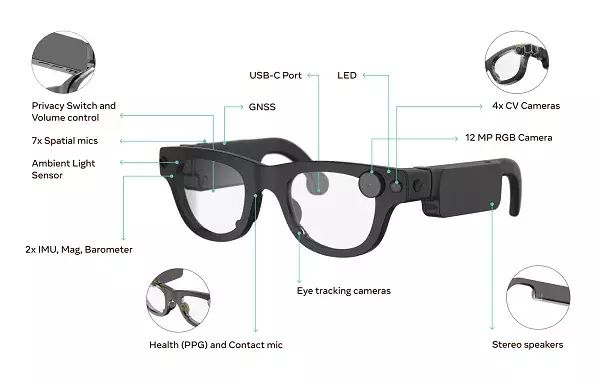Meta has embarked on a groundbreaking journey with its upcoming augmented reality (AR) glasses, the Aria Gen 2, aimed at transforming how we interact with the digital realm. This second iteration of the Aria glasses promises significant enhancements, shifting the paradigm of AR from mere novelty to practical utility, all the while prioritizing user comfort and style. Despite being still in development, the details that have emerged offer an exciting glimpse into a future where our everyday experiences are dramatically reshaped by this innovative technology.
Spotlight on Design and Ergonomics
One of the standout features of the Aria Gen 2 is its commitment to ergonomics and design aesthetics. We often think of wearable tech as bulky or unsightly, but Meta’s approach seeks to dispel this notion. Weighing in at a mere 74-76 grams, the glasses have been carefully crafted to provide such comfort that wearers might forget they’re even equipped with them. With eight available sizes that accommodate different head shapes and nose structures, Meta emphasizes customizability—an often overlooked aspect in tech design. The addition of folding arms is particularly noteworthy; it shows that practicality has been blended seamlessly with functionality.
Moreover, these glasses are not just designed for aesthetics; they harbor an array of advanced sensors that cater to both augmented reality experiences and research functionality. This blend of usability and innovation signifies a conscious move towards making AR more relevant and accessible.
Technological Advancements that Matter
As Meta continues to refine its AR technology, the enhancements in the Aria Gen 2’s camera systems are crucial for real-world application. In a world where variable lighting can dictate usability—from bright sunlight to dimly lit rooms—the improved sensors allow for operation in diverse environments. This versatility is essential for applications in education, design, and gaming, where varied settings can either enhance or hinder user experience.
Additionally, Meta’s introduction of a contact microphone integrated within the nose pad is a clever engineering feat aimed at solving a common challenge in AR interactions—audio capture. In settings with significant ambient noise, being able to communicate effortlessly remains a significant barrier to seamless interaction. The inclusion of eye and hand tracking further enhances the AR experience, suggesting that Meta is not just adding bells and whistles but is genuinely focused on creating a robust interactive platform.
Charting the Course Toward the Future
Mark Zuckerberg has described functional connected glasses as the “holy grail” of technology, suggesting that they have the potential to eclipse smartphones as our primary means of connectivity. This assertion reflects a bold vision for the future, one where the traditional barriers between digital and physical realms dissolve. While some may view the prospect of public interactions with invisible interfaces as peculiar, it is worth noting that technologies once considered odd—like using mobile phones—quickly integrated into daily life. As users acclimate to the novelty of such interactions, they may find themselves navigating a new landscape of communication that is far richer and more immersive than before.
The recent announcement that Meta plans to open applications to external developers later this year further solidifies the Aria Gen 2 as a platform for innovation. By inviting collaboration, Meta is not merely creating a product but fostering an ecosystem that will drive diverse applications—ranging from gaming to remote collaboration tools—that stand to benefit various industries and enhance everyday experiences.
Looking Ahead: The Anticipation of a Consumer Launch
While the consumer launch of Aria Gen 2 is not expected until 2027, the anticipation surrounding its debut is palpable. As we stand on the brink of significant technological evolution, it’s essential to consider the implications of such advances. The prospect of AR glasses acting as an integral part of our daily lives invites questions about privacy, societal norms, and the very fabric of human interaction. What will it mean for our relationships as digital augmentation becomes the norm? How will we recalibrate our understanding of shared spaces as personal experiences grow increasingly immersive and individualized?
In this context, Meta’s endeavor serves as both an opportunity and a challenge. The success of the Aria Gen 2 hinges not just on technological prowess but on societal acceptance and adaptation. As we move forward, the convergence of physical and digital worlds stands to redefine future generations’ social landscapes. The time to engage with these coming changes is now, as the future beckons with a promise of extraordinary interconnectedness and interaction.

